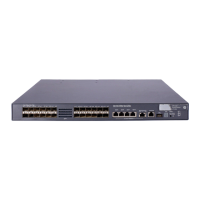10
3. The track module notifies the state change to the static routing module
4. The static routing module sets the static route as invalid.
NOTE:
For more information about the collaboration and the track module, see
High Availability
Configuration Guide
.
Supporting threshold monitoring
NQA supports threshold monitoring for performance parameters such as average delay jitter and packet
round-trip time. The performance parameters to be monitored are monitored elements. NQA monitors
threshold violations for a monitored element, and reacts to certain measurement conditions, for example,
sending trap messages to the network management server. This helps network administrators understand
the network service quality and network performance.
1. Monitored elements
Table 1 de
scribes the monitored elements and the NQA test types in which the elements can be
monitored.
Table 1 Monitored elements and NQA test types
Monitored elements
Test type supported
Probe duration
Tests excluding UDP jitter test and voice
test
Count of probe failures
Tests excluding UDP jitter test and voice
test
Packet round-trip time UDP jitter test and voice test
Count of discarded packets UDP jitter test and voice test
One-way delay jitter (source-to-destination and destination-to-
source)
UDP jitter test and voice test
One-way delay (source-to-destination and destination-to-source)
UDP jitter test and voice test
ICPIF (see “Configuring voice tests”) Voice test
MOS (see “Configuring voice tests”) Voice test
2. Threshold types
The following threshold types are supported:
• average—Monitors the average value of monitored data in a test. If the average value in a test
exceeds the upper threshold or goes below the lower threshold, a threshold violation occurs. For
example, you can monitor the average probe duration in a test.
• accumulate—Monitors total number of times the monitored data violates the threshold in a test. If the
total number of times reaches or exceeds a specified value, a threshold violation occurs.
• consecutive—Monitors the number of consecutive times the monitored data violates the threshold
since the test group starts. If the monitored data violates the threshold consecutively for a specified
number of times, a threshold violation occurs.

